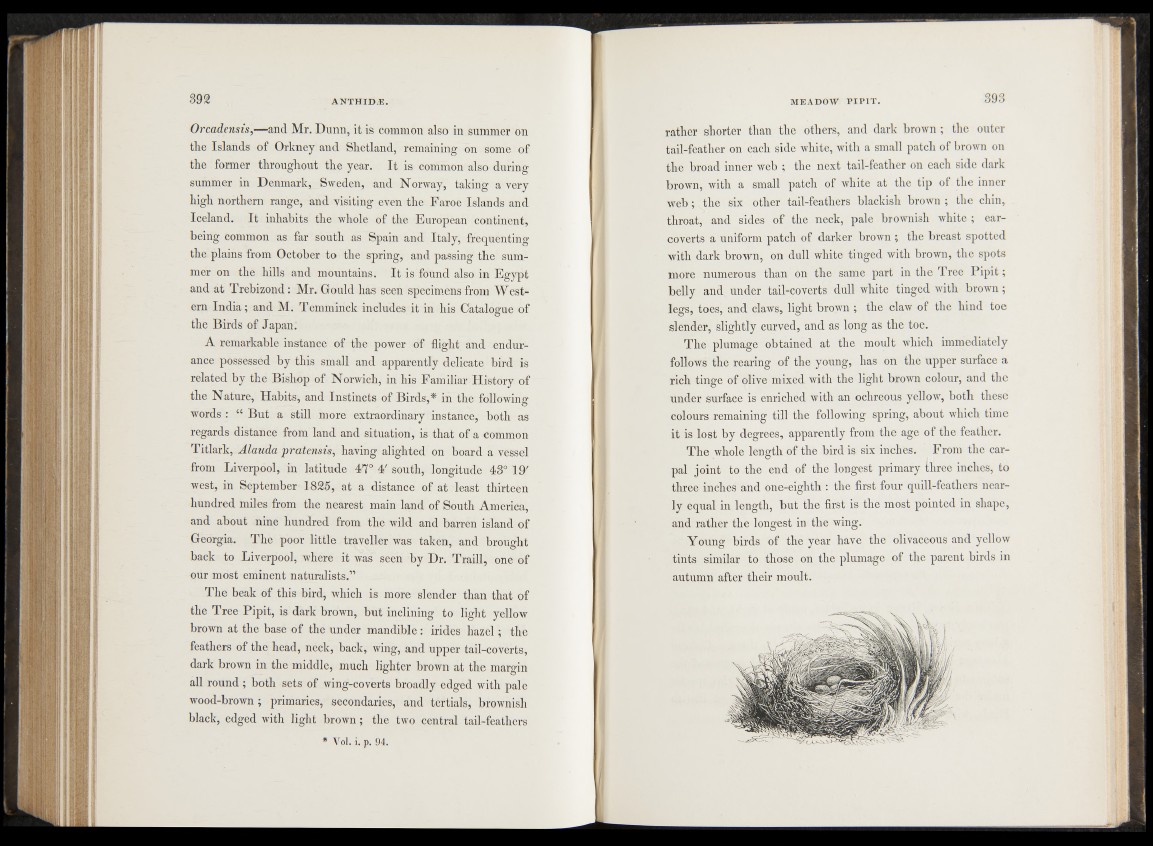
Orcadensis,—and Mr. Dunn, it is common also in summer on
the Islands of Orkney and Shetland, remaining on some of
the former throughout the year. It is common also during
summer in Denmark, Sweden, and Norway, taking a very
high northern range, and visiting even the Faroe Islands and
Iceland. It inhabits the whole of the European continent,
being common as far south as Spain and Italy, frequenting
the plains from October to the spring, and passing the summer
on the hills and mountains. It is found also in Egypt
and at Trebizond: Mr. Gould has seen specimens from Western
India; and M. Temminck includes it in his Catalogue of
the Birds of Japan.
A remarkable instance of the power of flight and endurance
possessed by this small and apparently delicate bird is
related by the Bishop of Norwich, in his Familiar History of
the Nature, Habits, and Instincts of Birds,* in the following
words : “ But a still more extraordinary instance, both as
regards distance from land and situation, is that of a common
Titlark, Alauda pratensis, having alighted on board a vessel
from Liverpool, in latitude 47° 4' south, longitude 43° 19'
west, in September 1825, at a distance of at least thirteen
hundred miles from the nearest main land of South America,
and about nine hundred from the wild and barren island of
Georgia. The poor little traveller was taken, and brought
back to Liverpool, where it was seen by Dr. Traill, one of
our most eminent naturalists.”
The beak of this bird, which is more slender than that of
the Tree Pipit, is dark brown, but inclining to light yellow
brown at the base of the under mandible: irides hazel; the
feathers of the head, neck, back, wing, and upper tail-coverts,
dark brown in the middle, much lighter brown at the margin
all round ; both sets of wing-coverts broadly edged with pale
wood-brown ; primaries, secondaries, and tertials, brownish
black, edged with light brown; the two central tail-feathers
* Vol. i. p. 94.
rather shorter than the others, and dark brown ; the outer
tail-feather on each side white, with a small patch of brown on
the broad inner web ; the next tail-feather on each side dark
brown, with a small patch of white at the tip of the inner
web; the six other tail-feathers blackish brown ; the chin,
throat, and sides of the neck, pale brownish white ; ear-
coverts a uniform patch of darker brown; the breast spotted
with dark brown, on dull white tinged with brown, the spots
more numerous than on the same part in the Tree P ip it;
belly and under tail-coverts dull white tinged with brown;
legs, toes, and claws, light brown ; the claw of the hind toe
slender, slightly curved, and as long as the toe.
The plumage obtained at the moult which immediately
follows the rearing of the young, has on the upper surface a
rich tinge of olive mixed with the light brown colour, and the
under surface is enriched with an ochreous yellow, both these
colours remaining till the following spring, about which time
it is lost by degrees, apparently from the age of the feather.
The whole length of the bird is six inches. From the carpal
joint to the end of the longest primary three inches, to
three inches and one-eighth : the first four quill-feathers nearly
equal in length, but the first is the most pointed in shape,
and rather the longest in the wing.
Young birds of the year have the olivaceous and yellow
tints similar to those on the plumage of the parent birds in
autumn after their moult.